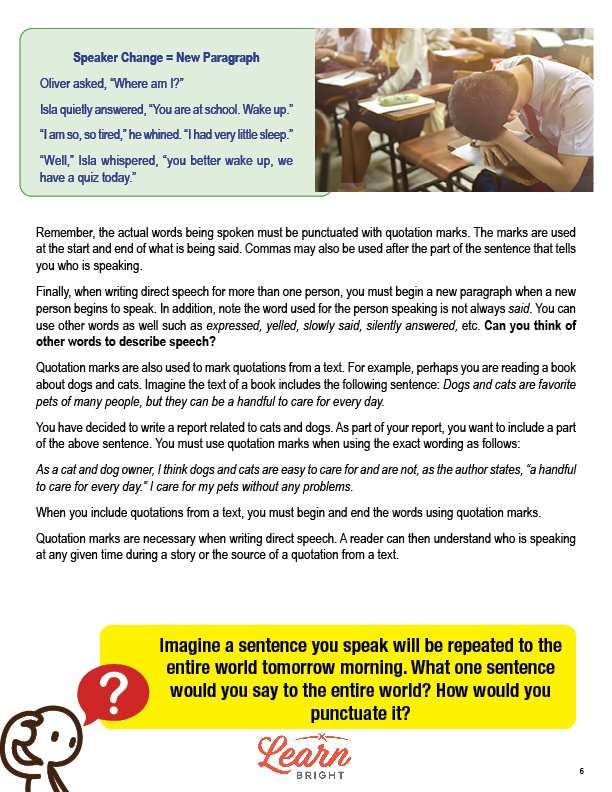Description
What our Direct Speech Punctuation lesson plan includes
Lesson Objectives and Overview: Direct Speech Punctuation teaches students how to properly use commas and quotation marks when writing direct speech or quotations. This lesson is for students in 4th grade.
Classroom Procedure
Every lesson plan provides you with a classroom procedure page that outlines a step-by-step guide to follow. You do not have to follow the guide exactly. The guide helps you organize the lesson and details when to hand out worksheets. It also lists information in the green box that you might find useful. You will find the lesson objectives, state standards, and number of class sessions the lesson should take to complete in this area. In addition, it describes the supplies you will need as well as what and how you need to prepare beforehand. The only supplies needed for this lesson are the handouts, which you can copy ahead of time.
Options for Lesson
Included with this lesson is an “Options for Lesson” section that lists a number of suggestions for activities to add to the lesson or substitutions for the ones already in the lesson. One optional addition to this lesson is to show a video of a conversation between two people and have students record the direct speech, using the correct punctuation. You can also use a story that includes dialogue as an example of correctly written direct speech.
Teacher Notes
The teacher notes page includes a paragraph with additional guidelines and things to think about as you begin to plan your lesson. This page also includes lines that you can use to add your own notes as you’re preparing for this lesson.
DIRECT SPEECH PUNCTUATION LESSON PLAN CONTENT PAGES
Direct Speech
The Direct Speech Punctuation lesson plan includes three content pages. The lesson begins by reminding students that, when they speak to other people, the words they say are their own, and the sentences are created by their minds and belong to them. Likewise, when you read a comic book, the speech bubbles indicate the words of a specific character. These are both examples of direct speech.
Direct speech is different from indirect speech, which is when you relay the words of someone else, often not word-for-word. For example, if your mom says to tell your little brother it’s time for dinner, you could relay her words as indirect speech (Mom told me to tell you we have to go eat) or direct speech (Mom said, “It is time for dinner”). Direct speech means you are relaying the exact words said by another person. When you use indirect speech, there aren’t any special punctuation marks that you need to us.
However, we do have specific punctuation for direct speech, like commas and quotation marks. We use these when we show the direct speech of another person or of a character in a book. We also use them when quoting from a text, like a speech or an article.
Punctuating Direct Speech/Quotations
While students are familiar with commas and how to use them, they might not have a lot of practice using quotation marks in their writing. We use quotation marks for writing quotes. They look like pairs of upside-down commas. We place them before and after the quote. We also sometimes call them speech marks.
In the example sentence Tom said, “I have decided to stay home from school today.” we put a quotation mark before the first word that he said (I) and after the last word that he said (today) and the period. We also use a comma after the word said. It’s important to note that we put the second quotation mark after the period or other punctuation, not before.
The lesson includes several other examples that illustrate how to properly use commas and quotation marks for direct speech quotations. Students should review these examples to better understand where and how to use punctuation with quotations. One important rule they will learn is that you need a new paragraph for each speaker change. For example:
Oliver asked, “Where am I?”
Isla quietly answered, “You are at school. Wake up.”
It’s important to remember that we must punctuate the actual words being spoken with quotation marks, placed at the start and end of what’s being said. We can also use commas after the part of the sentence that tells you who is speaking. You can use words other than said to indicate direct speech, like expressed, yelled, slowly said, silently answered, and more.
We also use quotation marks to mark quotations from a text. If you’re writing a report and want to include a sentence or fact from a book you read, you have to use quotation marks when using the exact wording from the book. The lesson includes an example of this.
Using proper punctuation for direct speech and quotations is very important, as it helps readers understand who is speaking and what they said.
DIRECT SPEECH PUNCTUATION LESSON PLAN WORKSHEETS
The Direct Speech Punctuation lesson plan includes three worksheets: an activity worksheet, a practice worksheet, and a homework assignment. You can refer to the guide on the classroom procedure page to determine when to hand out each worksheet.
RECORDING DIRECT SPEECH ACTIVITY WORKSHEET
Students will work in groups to complete the activity worksheet. To begin, two students in the group will choose a topic and discuss it for two minutes, taking turns speaking. Meanwhile, the other two members will write down as much of their conversation as possible using the space provided on the worksheet, listening carefully. They will then switch places and repeat. After both pairs have discussed a topic and recorded a conversation, they will take the information they’ve written down and correctly write the direct speech on the worksheet without using the word said.
CORRECTING SENTENCES PRACTICE WORKSHEET
The practice worksheet asks students to complete three exercises. The first asks them to correctly add commas and quotation marks to ten sentences where needed. Next, the second asks them to write a direct speech sentence for each of the given situations. The lesson provides an example for them to work from. Finally, the third asks them to read a paragraph and correctly add quotation marks where needed. They must also answer one final question about the paragraph.
DIRECT SPEECH PUNCTUATION HOMEWORK ASSIGNMENT
For the homework assignment, students will complete three short exercises. For the first, they will correctly rewrite a paragraph, replacing the word said with a better word. Next, they will read another paragraph and will correctly add quotation marks where needed. Finally, they will think about a conversation they recently had and will correctly write some of it out on the lines provided.
Worksheet Answer Keys
This lesson plan includes answer keys for the practice worksheet and the homework assignment. If you choose to administer the lesson pages to your students via PDF, you will need to save a new file that omits these pages. Otherwise, you can simply print out the applicable pages and keep these as reference for yourself when grading assignments.









